在还原UI的时候我们常会发现一个问题,按照Sketch标注的尺寸去还原设计稿中的文字会产生几个Px的误差,字符上下有些许空白,以致于后期设计审查时频繁微调。
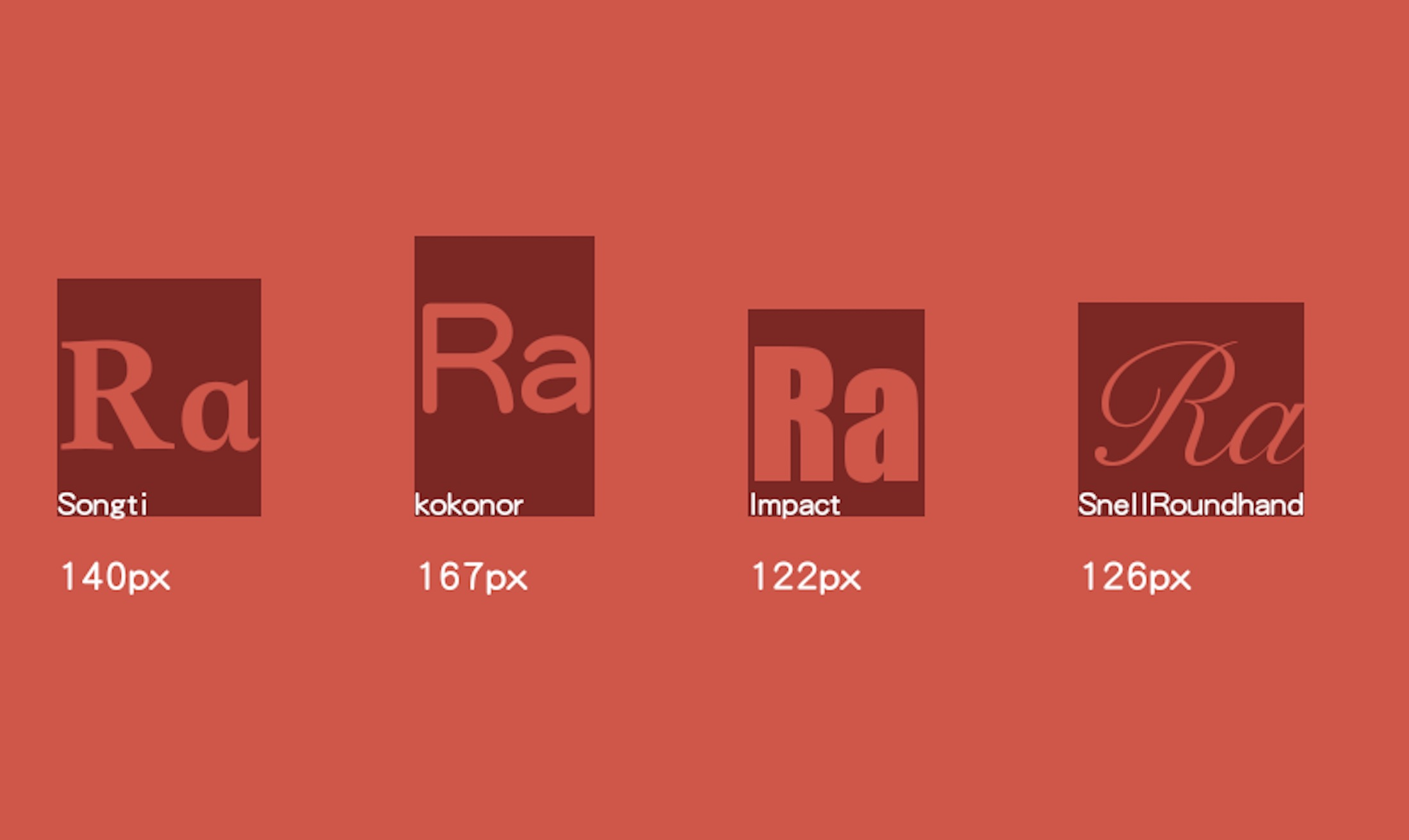
Android设备上100Px的不同字体显示的真实高度(includeFontPadding:false,下同),不同的字体的实际高度均不一致。
所以,为了精确还原我们需要了解1Px的字体到底有多高?
FontMetrics
在TrueType字体文件中,每一款字体文件都会定义一个em-square,它被存放于ttf文件中的'head'表中,一个em-square值可以为1000、1024或者2048等。
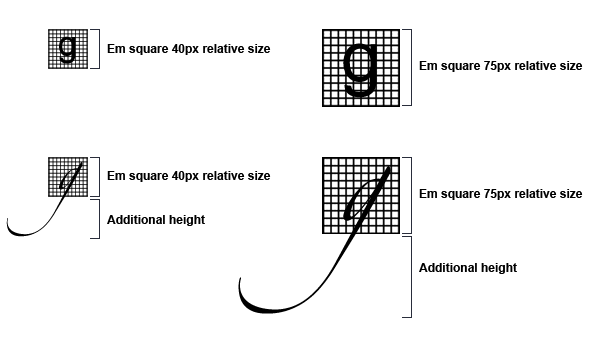
em-square相当于字体的一个基本容器,也是textSize缩放的相对单位。金属时代一个字符不能超过其所在的容器,但是在数字时代却没有这个限制,一个字符可以扩展到em-square之外,这也是设计一些字体时候挺方便的做法。
后续的ascent、descent以及lineGap等值都是相对于em-square的相对值。
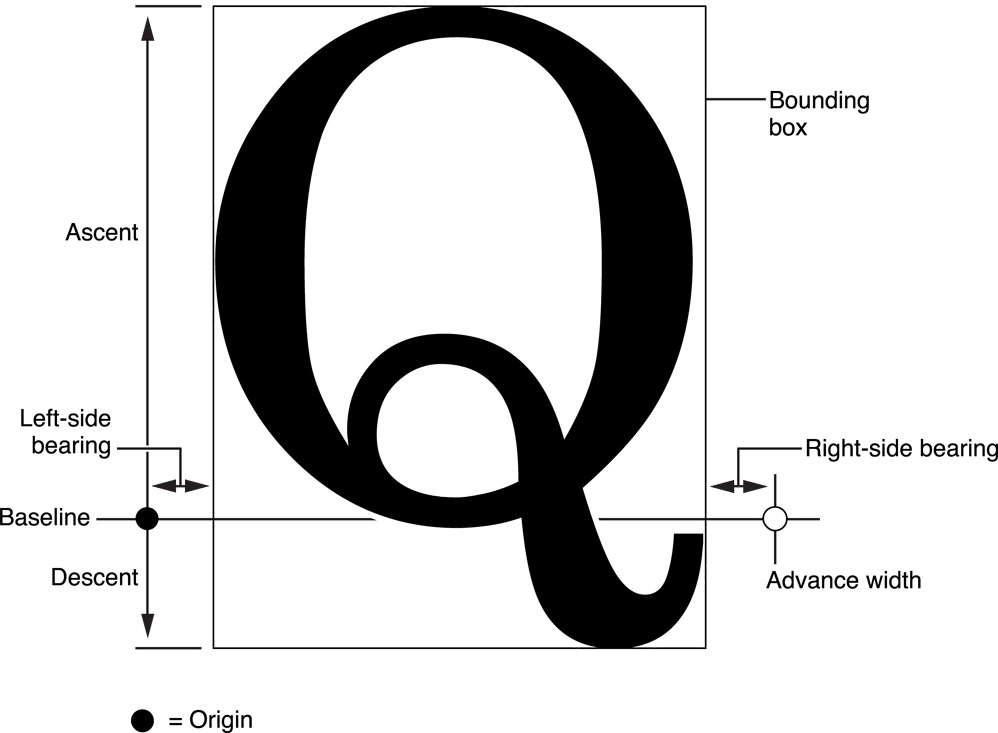
ascent代表单个字符最高处至baseLine的推荐距离,descent代表单个字符最低处至baseLine的推荐距离。字符的高度一般由ascent和descent共同决定,对于em-square、ascent与descent我们可以通过FontTools解析字体文件获得。
FontTools
FootTools是一个完善易用的Python字体解析库,可以很方便地将TTX、TTF等文件转成文本编辑器打开的XML描述文件。
FontTools
安装
pip install fonttools
转码
ttx Songti.ttf
转码后会在当前目录生成一个Songti.ttx的文件,我们用文本编辑器打开并搜索'head'。
<head>
<!-- Most of this table will be recalculated by the compiler -->
<tableVersion value="1.0"/>
<fontRevision value="1.0"/>
<checkSumAdjustment value="0x7550297b"/>
<magicNumber value="0x5f0f3cf5"/>
<flags value="00000000 00001011"/>
<unitsPerEm value="1000"/>
<created value="Thu Nov 11 14:47:27 1999"/>
<modified value="Tue Nov 14 03:02:03 2017"/>
<xMin value="-99"/>
<yMin value="-150"/>
<xMax value="1032"/>
<yMax value="860"/>
<macStyle value="00000000 00000000"/>
<lowestRecPPEM value="12"/>
<fontDirectionHint value="1"/>
<indexToLocFormat value="1"/>
<glyphDataFormat value="0"/>
</head>
其中unitsPerEm便代表em-square,值为1000。
在Windows系统中,Ascent与Descent由'OS_2'表中的usWinAscent与usWinDescent决定。
但是在MacOS、iOS以及Android中,Ascent与Descent由'hhea'表中的ascent与descent决定。
<hhea>
<tableVersion value="0x00010000"/>
<ascent value="1060"/>
<descent value="-340"/>
<lineGap value="0"/>
<advanceWidthMax value="1000"/>
<minLeftSideBearing value="-99"/>
<minRightSideBearing value="-50"/>
<xMaxExtent value="1032"/>
<caretSlopeRise value="1"/>
<caretSlopeRun value="0"/>
<caretOffset value="0"/>
<reserved0 value="0"/>
<reserved1 value="0"/>
<reserved2 value="0"/>
<reserved3 value="0"/>
<metricDataFormat value="0"/>
<numberOfHMetrics value="1236"/>
</hhea>
Ascent与Descent的值为以baseLine作为原点的坐标,根据这三个值,我们可以计算出字体的高度。
TextHeight = (Ascent - Descent) / EM-Square * TextSize
LineHeight = (Ascent - Descent + LineGap) / EM-Square * TextSize
上表中,我们已知宋体-常规的ascent为1060,descent为-340。
TextSize为100Pixcel的宋体常规字符高度为
height = (1060 - (-340)) / 1000 * 100 = 140px
所以对于宋体,1Px的字高为1.4Px。
常见字体LineGap一般均为0,所以一般lineHeight = textHeight。
常用字体参数
iOS默认字体 - [San Francisco]
<unitsPerEm value="2048"/>
<ascent value="1950"/>
<descent value="-494"/>
<lineGap value="0"/>
TextHeight = 1.193359375 TextSize
Android默认字体 - [Roboto - Regular]
<unitsPerEm value="2048"/>
<ascent value="1900"/>
<descent value="-500"/>
<lineGap value="0"/>
<yMax value="2163"/>
<yMin value="-555"/>
TextHeight = 1.17187502 TextSize
UI适配误区
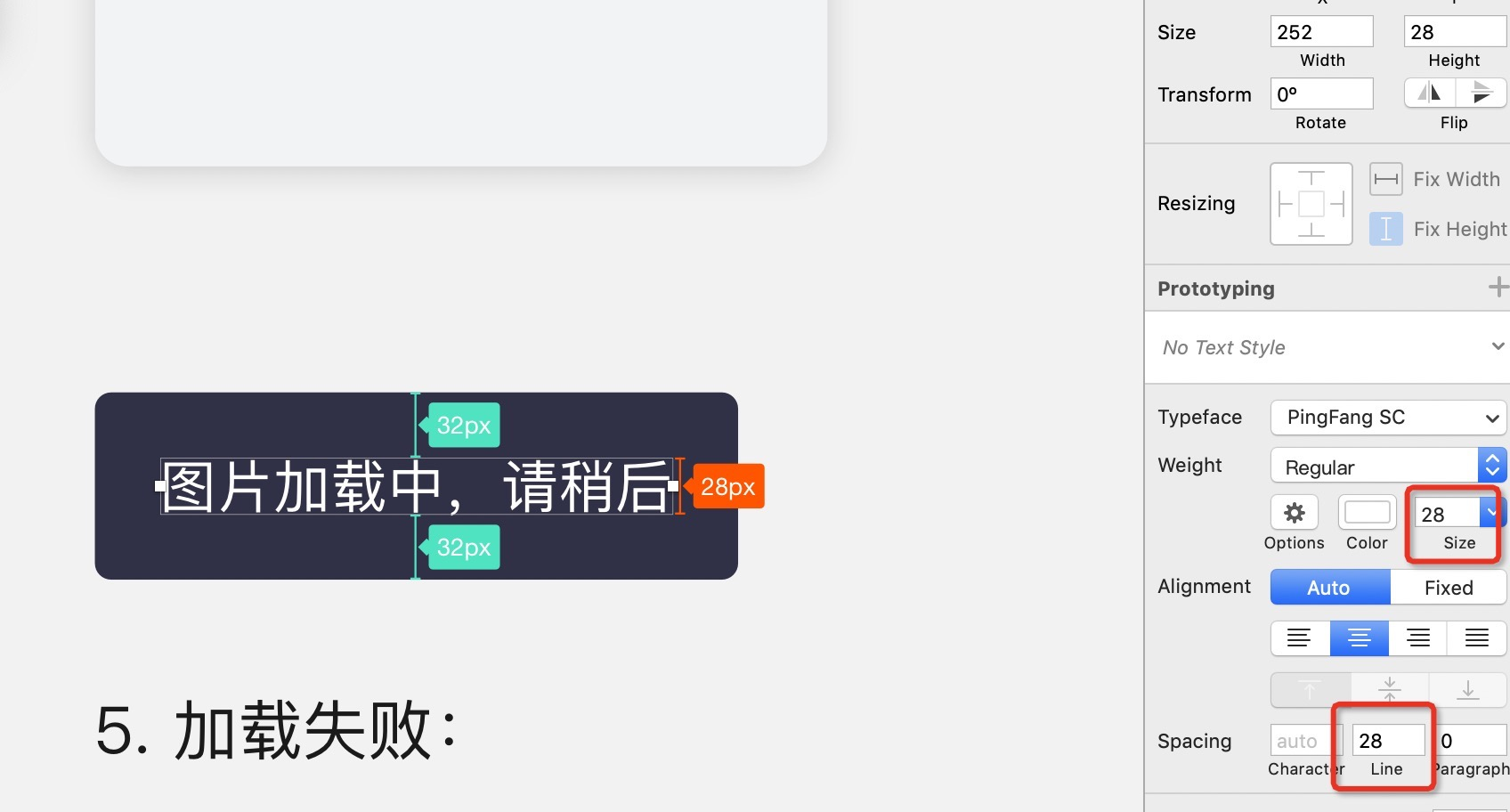
Sketch设计稿中,字体为28px,字体居上下边框为32px,如果按照这样的参数进行UI还原的话,以Android默认设备为例,外围背景会比原来高28 * (1.17 - 1) = 4.76个像素(Android IncludeFontPadding = false)。
这是因为该设计稿中框选的lineHeight = textSize,这在一般的字体中是不正确的!会导致一些文字显示不下或者两行文字的上下端部分叠加。同理,用字的高度去得出TextSize也是不正确的!框选文字的时候不能刚刚够框选中文,实际上这种做法输入框输入个'j'便会超出选框,虽然仍能显示。
正确做法应该将lineHeight设置为 28 * 1.17 = 33,然后再测出上下边距。
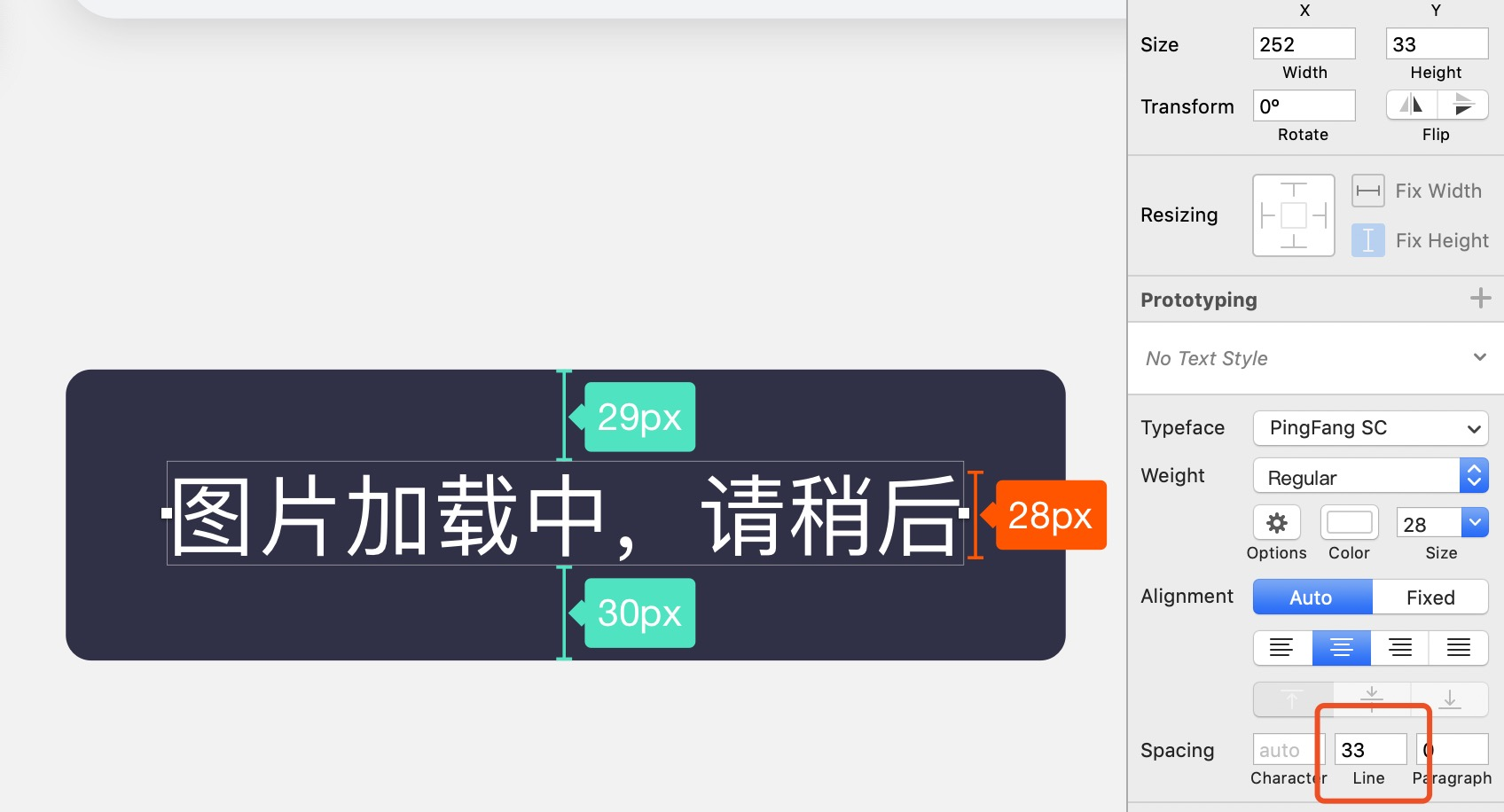
lineHeight变大了,上下边距相应减少为29px与30px。
对于设计稿中LineHeight > 字体实际高度(如1.17 * textSize)的情况下,我们可以设置lineSpace = lineHeight - 1.17 textSize 去精确还原行间距。
结论:UI中字体还原不到位一般是对字体高度理解有误解,实际上1Px的字体在客户端中一般不等于1Px,而等于1.19(iOS) or 1.17 (Android) 个Px。
Android IncludeFontPadding
/**
* Set whether the TextView includes extra top and bottom padding to make
* room for accents that go above the normal ascent and descent.
* The default is true.
*
* @see #getIncludeFontPadding()
*
* @attr ref android.R.styleable#TextView_includeFontPadding
*/
public void setIncludeFontPadding(boolean includepad) {
if (mIncludePad != includepad) {
mIncludePad = includepad;
if (mLayout != null) {
nullLayouts();
requestLayout();
invalidate();
}
}
}
Android TextView 默认IncludeFontPadding为开启状态,会在每一行字的上下方留出更多的空间。
if (getIncludeFontPadding()) {
fontMetricsTop = fontMetrics.top;
} else {
fontMetricsTop = fontMetrics.ascent;
}
if (getIncludeFontPadding()) {
fontMetricsBottom = fontMetrics.bottom;
} else {
fontMetricsBottom = fontMetrics.descent;
}
我们通过Textview的源码可以发现,只有IncludeFontPadding = false的情况下,textHeight计算方式才与iOS端与前端相统一。默认true情况会选取top与bottom,这两个值在一般情况下会大于ascent和descent,但也不是绝对的,在一些字体中会小于ascent和descent。
public static class FontMetrics {
/**
* The maximum distance above the baseline for the tallest glyph in
* the font at a given text size.
*/
public float top;
/**
* The recommended distance above the baseline for singled spaced text.
*/
public float ascent;
/**
* The recommended distance below the baseline for singled spaced text.
*/
public float descent;
/**
* The maximum distance below the baseline for the lowest glyph in
* the font at a given text size.
*/
public float bottom;
/**
* The recommended additional space to add between lines of text.
*/
public float leading;
}
对于top和bottom,这两个值在 ttc/ttf 字体中并没有同名的属性,应该是Android独有的名称。我们可以寻找获取FontMetrics的方法(getFontMetrics)进行溯源。
public float getFontMetrics(FontMetrics metrics) {
return nGetFontMetrics(mNativePaint, metrics);
}
@FastNative
private static native float nGetFontMetrics(long paintPtr, FontMetrics metrics);
Paint的getFontMetrics最终调用了native方法nGetFontMetrics,nGetFontMetrics的实现在Android源码中的Paint_Delegate.java类
@LayoutlibDelegate
/*package*/
static float nGetFontMetrics ( long nativePaint, long nativeTypeface,FontMetrics metrics){
// get the delegate
Paint_Delegate delegate = sManager.getDelegate(nativePaint);
if (delegate == null) {
return 0;
}
return delegate.getFontMetrics(metrics);
}
private float getFontMetrics (FontMetrics metrics){
if (mFonts.size() > 0) {
java.awt.FontMetrics javaMetrics = mFonts.get(0).mMetrics;
if (metrics != null) {
// Android expects negative ascent so we invert the value from Java.
metrics.top = -javaMetrics.getMaxAscent();
metrics.ascent = -javaMetrics.getAscent();
metrics.descent = javaMetrics.getDescent();
metrics.bottom = javaMetrics.getMaxDescent();
metrics.leading = javaMetrics.getLeading();
}
return javaMetrics.getHeight();
}
return 0;
}
由上可知top和bottom实际上取得是Java FontMetrics中的MaxAscent与MaxDescent,对于MaxAscent的取值OpenJDK官网论坛给出了答案:
Ideally JDK 1.2 should have used the OS/2 table value for usWinAscent,
or perhaps sTypoAscender (so there's at least three choices here,
see http://www.microsoft.com/typography/otspec/recom.htm#tad for
more info).
For max ascent we could use the yMax field in the font header.
In most fonts I think this is equivalent to the value we retrieve from the hhea table,
hence the observation that both methods return the max ascent.
所以我们可以获知,Android默认取的是字体的yMax高度,通过查找Apple Font手册我们可以知道yMax是字符的边界框范围,所以我们可以得出以下公式:
includeFontPadding default true
TextHeight = (yMax - yMin) / EM-Square * TextSize
includeFontPadding false
TextHeight = (ascent - descent) / EM-Square * TextSize
Android默认字体roboto在默认includeFontPadding = true情况下,textHeight = 1.32714844 textSize。
所以Android UI适配,如果不改变includeFontPadding,可以将系数调整为1.327
总结
相同textSize的字体,高度由字体本身决定
字体公式
TextHeight = (Ascent - Descent) / EM-Square * TextSize
LineHeight = (Ascent - Descent + LineGap) / EM-Square * TextSize
Android - includeFontPadding true
TextHeight = (yMax - yMin) / EM-Square * TextSize
客户端默认字体下,1个Px的高度值并不为1Px
iOS TextHeight = 1.193359375 TextSize
Android - IncludePadding : true TextHeight = 1.32714844 TextSize
Android - IncludePadding : false TextHeight = 1.17187502 TextSize